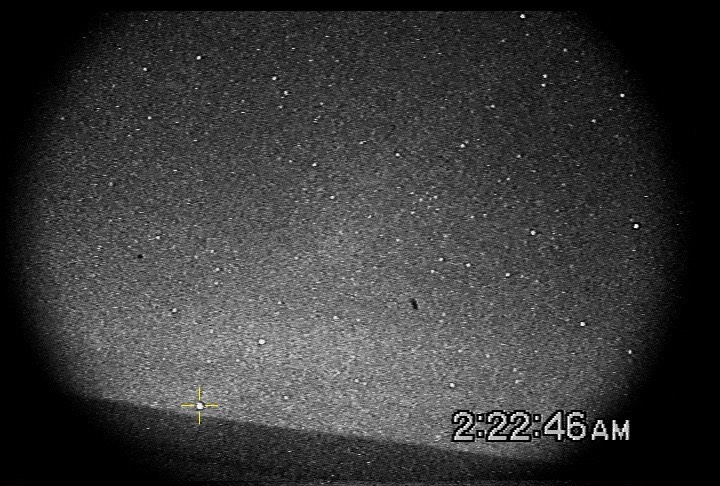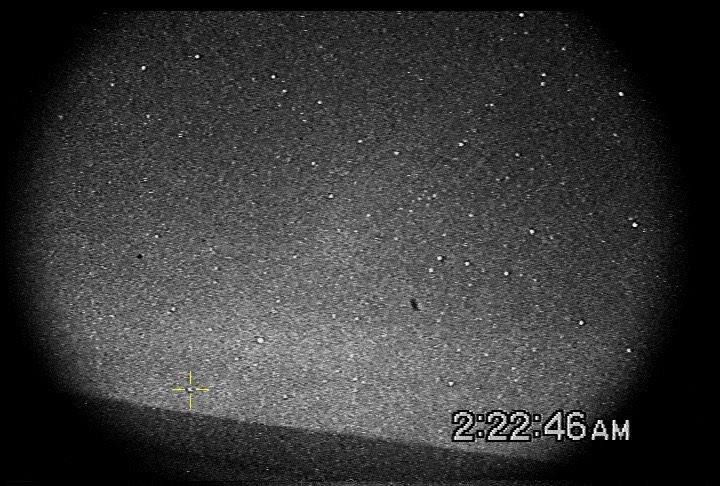A Strange Leonid
I happened to notice an odd Leonid, only because it triggered a warning in the analysis software that its reported angular altitude was negative -- an obvious impossibility. At first I was tempted to dismiss it as a fluke due to the occasional drift in the star registration system. However, on closer examination, I discovered that this Leonid was very close to the horizon because the aircraft was turning, dipping the camera way down to the horizon. Here’s one of later frames for this Leonid, which is marked by the yellow crosshairs:

You can clearly see the ground on the frame; it is tilted because the aircraft keeps its nose up in flight. The horizon line shows the ground rather than a cloud layer, because we’re looking south from the middle of the Mediterranean; my calculations indicate that the horizon line is in the Sahara desert of western Egypt or Libya. The Sahara desert is rarely cloudy, so I’m pretty sure that we’re looking at the ground here, not a cloud deck.
To understand the weirdness, you need to see two more frames: the first frame and the last frame of the Leonid’s track. Here they are:

First frame
Last frame
In order to be very certain of my measurements, I decided to plot the positions of the Leonid (as reported by the software) with the horizon line (as calculated from measurements of its slope on a number of frames). Here’s the graph of those positions in pixels on the frame:
The red line represents an eyeballed best fit line; the open red circle represents my eyeballed correction to the position of the first red dot, based on the spacings of all the other red dots. The black near-vertical line is the distance from that open red circle to the horizon; I measure it to represent 1.51º of angular distance. Thus, the first appearance of the Leonid was at an angular altitude of 1.51º. Now, experience has shown that Leonids first become visible when they are at an altitude of about 119 km. Our aircraft was at an altitude of 10 km, so the distance from the aircraft to the Leonid at first sighting is (from simple trigonometry) about 4,000 km -- putting this Leonid somewhere over Angola! Obviously, something is seriously wrong with my calculation. The solution is to take into account the curvature of the earth’s surface:
In this diagram, R is the radius of the earth, H is the height of the Leonid, and A is the earth-angle between the airplane and the Leonid. We know that Angle 123 is 91.5º. So we need merely solve for the oblique triangle 123 as follows:
sin(angle231) = R sin(91.5º)/(R+H) => angle231= 79.4º
angle A = 180º - 91.5º - 79.4º = 9.1º
distance 23 = (R+H)sin(79.4º)/sin(91.5º) = 1023 km.
Thus, the Leonid is a mere 1023 km away from the aircraft -- somewhere over southern Egypt or Libya. But there’s one other problem: the final frame. Look closely: the Leonid is almost on the horizon. My graph indicates that it is at most one pixel above the horizon. That means that the Leonid was 0.05º above the horizon at that time. Again, the solution to this problem is to apply the curvature of the earth; when I do this calculation, I get an altitude of 82 km, which agrees fairly well, considering the extreme angles we’re using, with the height of about 90 km calculated from its expected speed.
